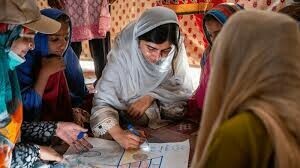KARACHI, Dec 13: As malnutrition in children under five years of age is growing across the country, paediatricians and health managers at a seminar on Tuesday called for a multi-sectoral approach for the provision of a cheap and effective indigenous supplementary food to children up to the age of two years.
They said that unless we did something practical to rehabilitate our poverty-stricken and malnourished children and improve their nutrition status, it would be difficult to slacken the pace of infant morbidity and mortality, and Pakistan would fail to meet its millennium development goals.
The findings of a national nutrition survey, yet to be launched officially, were also highlighted at the seminar. According to this year’s survey, the high figure of malnutrition in Pakistani children was 15.1 per cent, while in Sindh it was 17.5pc.
The overall malnutrition rate in children was determined as 11.6pc in the 2001 national survey.
The seminar was organised by a community-based organisation, the Health Education and Literacy Programme (HELP), to disseminate the results of a project on innovative ideas in nutrition for children awarded to it by the World Bank in 2009.
Speaking as the chief guest, the additional secretary of the Sindh health department, Dr Khalid Shaikh, said the flood-related disaster in the province had highlighted the fact, among other things, that malnutrition of women and children in Sindh was above the crisis level.
“The survey done after the floods of 2010 revealed acute malnutrition rates in children under five years of age. The rates were 23pc in northern Sindh and 21pc in southern Sindh, while malnutrition in women was 12pc, definitely a very worrying situation,” he said, adding that the national nutrition survey done in 2011 also painted a bleak picture as compared to the previous national survey.
However, according to him, the Sindh government had made the issue of malnutrition a major priority to address in addition to the eradication of polio from the province. “We have to address not only the nutrition status of the child, but the issue of nutrition of the child’s mother during pregnancy and ensure breastfeeding together with an appropriate diet for the child after he or she completes six months,” he said, adding that the government would consider utilising the local high-density food on a larger population.
A senior paediatrician and former head of the Dow University of Health Sciences’ paediatrics department, Prof D.S. Akram, who is also honorary chairperson of HELP, told the participants about the implementation of the World Bank project on ‘home-based nutrition management of severely malnourished children’ in Shahdadpur taluka of Sanghar.
A high-density diet (HDD), which could be made at home, hospital or factory with gram powder, rice powder, milk powder, sugar and oil, and could be taken as halwa, gruel or liquid drink, was given as a supplement to severely malnourished 123 children up to the age of two years at their homes.
Dr Akram said that in the project all children gained weight and 85pc children reached the normal weight in four to five months. The cost of the treatment was significantly less than that of imported therapeutic food, she said, adding that the pilot project and the product had shown no side effects. It was found efficacious and could be replicated on a large scale jointly by the government and nongovernmental organisations.
A former provincial focal person on nutrition and an official of the Sindh health department, Dr Dure Shehwar Khan, stressed the need for countrywide action and direct nutrition interventions for the treatment of children, with the highest priority to the “minus nine to 24 months window opportunity” and multi-sectoral approach involving the agriculture, social protection, health, education, water and sanitation sectors.
She suggested good nutritional practices, including breastfeeding, complimentary feeding for infants after the age of six months and improved hygiene practices, including hand washing. She also called for an increased intake of vitamins and minerals by children and iron-folic acid supplements for pregnant women to prevent and treat anaemia.
She also shared some salient features of the latest national nutrition survey (2011) and said that the number of malnourished children had increased. Against the general perception, the South Asia region had a higher malnourished and underweight child population than Africa.
Prof A.G. Billoo said the issue of malnourishment was needed to be addressed right from the days of pregnancy, which was possible through education of parents and provision of high-density food and proteins to children right from the seventh month of the child.













































Dear visitor, the comments section is undergoing an overhaul and will return soon.